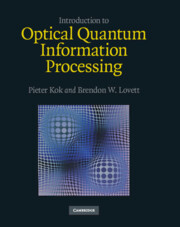Book contents
- Frontmatter
- Dedication
- Contents
- Preface
- Part I Quantum optics and quantum information
- Part II Quantum information in photons and atoms
- Part III Quantum information in many-body systems
- 8 Quantum communication with continuous variables
- 9 Quantum computation with continuous variables
- 10 Atomic ensembles in quantum information processing
- 11 Solid-state quantum information carriers
- 12 Decoherence of solid-state qubits
- 13 Quantum metrology
- Appendix A Baker–Campbell–Haussdorff relations
- Appendix B The Knill–Laflamme–Milburn protocol
- Appendix C Cross–Kerr nonlinearities for single photons
- References
- Index
8 - Quantum communication with continuous variables
from Part III - Quantum information in many-body systems
Published online by Cambridge University Press: 05 July 2014
- Frontmatter
- Dedication
- Contents
- Preface
- Part I Quantum optics and quantum information
- Part II Quantum information in photons and atoms
- Part III Quantum information in many-body systems
- 8 Quantum communication with continuous variables
- 9 Quantum computation with continuous variables
- 10 Atomic ensembles in quantum information processing
- 11 Solid-state quantum information carriers
- 12 Decoherence of solid-state qubits
- 13 Quantum metrology
- Appendix A Baker–Campbell–Haussdorff relations
- Appendix B The Knill–Laflamme–Milburn protocol
- Appendix C Cross–Kerr nonlinearities for single photons
- References
- Index
Summary
Qubits are not the only information carriers that can be used for quantum information processing. In this chapter, we will focus on quantum communication with ‘continuous quantum variables’, or continuous variables for short. In the context of quantum information processing we will also call continuous variables ‘qunats’. We have seen in Chapter 2 that a natural representation of a continuous variable is given by the position of a particle. The conjugate continuous variable is then the momentum of the particle. Unfortunately, the eigenstates of the position and momentum operators are not physical, and we have to construct suitable approximations to these states that can be created in the laboratory. Any practical information processing device must then take into account the deviation of the actual states from the ideal position and momentum eigenstates. Rather than the position and momentum of a particle, we will consider here the two position and momentum quadratures of an electromagnetic field mode. These operators obey the same commutation relations as the canonical position and momentum operators, but they are not the physical position and momentum of field excitations. Approximate eigenstates of the quadrature operators can be constructed in the form of squeezed coherent states. We define a quantum mechanical phase space for quadrature operators, similar to a classical phase space for position and momentum. Probability distributions in the classical phase space then become quasi-probability distributions over the quadrature phase space.We will develop one of these distributions, namely the Wigner function, and identify certain phase-space transformations of the Wigner function with linearoptical and squeezing operations.
Information
- Type
- Chapter
- Information
- Introduction to Optical Quantum Information Processing , pp. 255 - 293Publisher: Cambridge University PressPrint publication year: 2010
